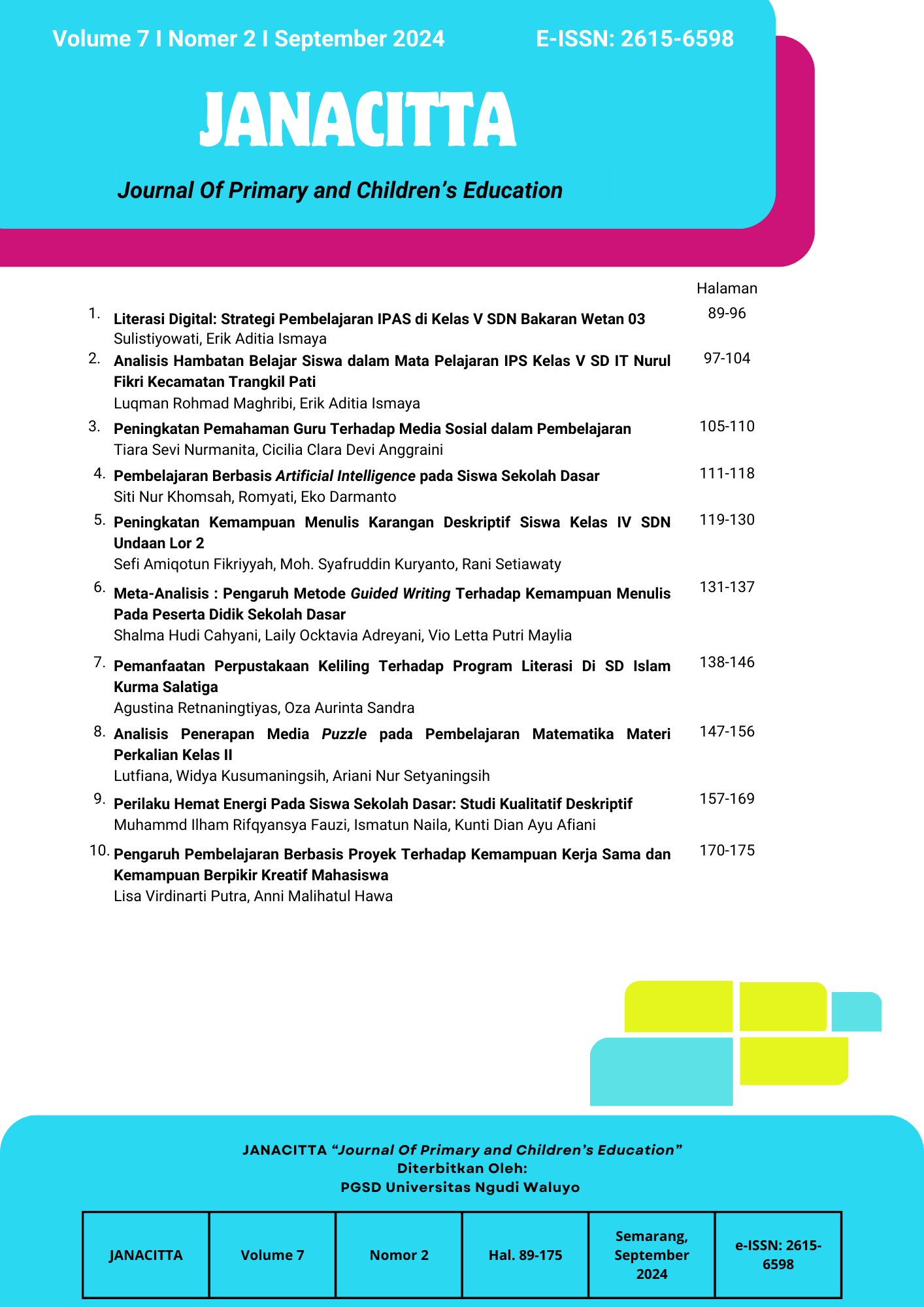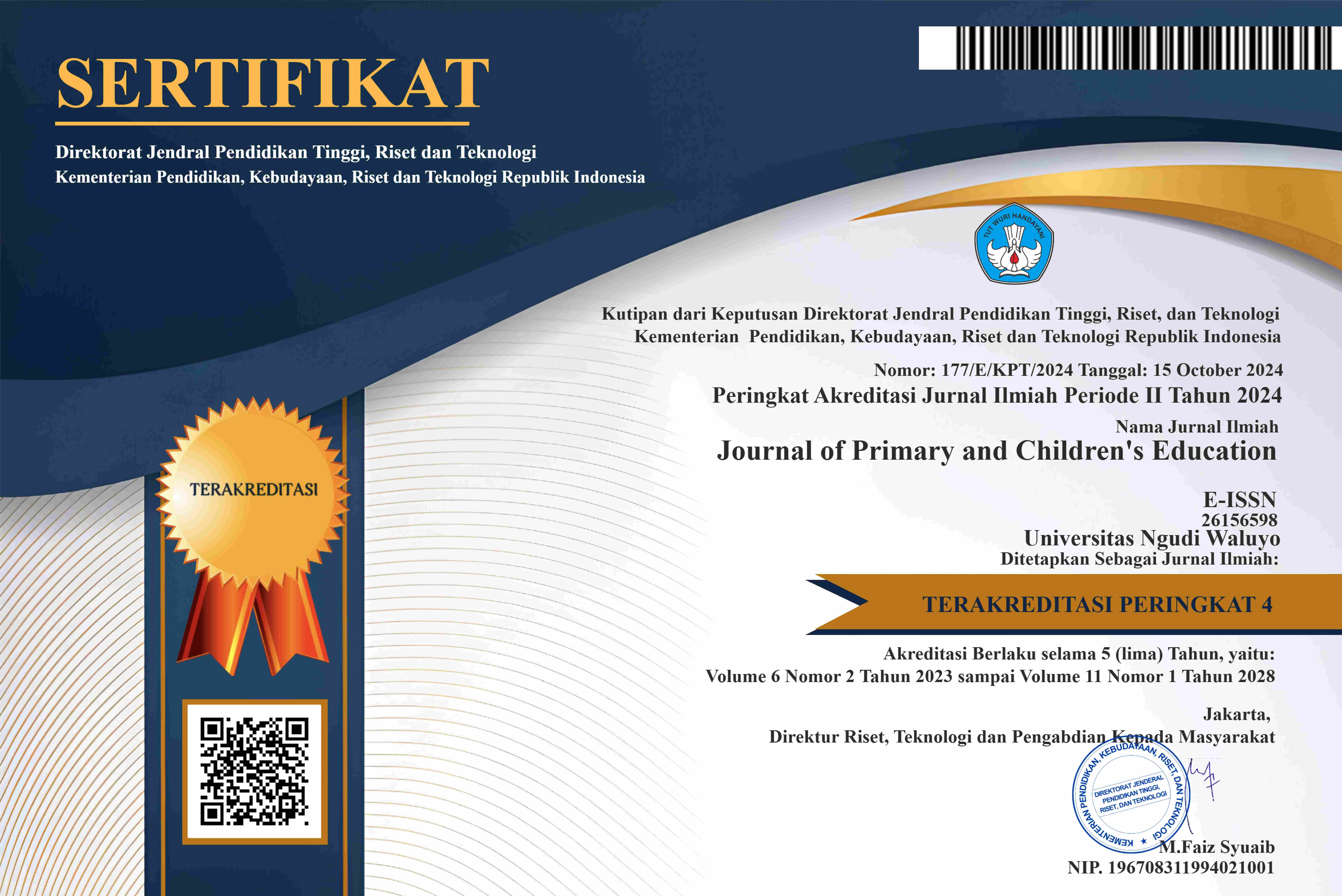Peningkatan Pemahaman Guru Terhadap Media Sosial dalam Pembelajaran
DOI:
https://doi.org/10.35473/jnctt.v7i2.3028Abstract
Abstract
The limited use of media makes learning less engaging and can cause students to feel bored. This research aims to examine the utilization of social media to enhance the learning process. Data were collected from statements made by 70 elementary school teachers who responded to a Google Forms questionnaire. The data obtains the grade levels at which teachers teach, the social media platforms, utilization and the impact. The data is processed with Google Forms software in the form of pie charts, while respondents' answers are summarized and processed using a word cloud. The majority of respondents are teachers, teach in grade 1 (28.8%), with only 6.8% teaching in grade 6. The social media platform most commonly used by teachers for teaching was WhatsApp (74.6%), YouTube had the lowest usage (1.7%). Teachers used WhatsApp to send lesson materials (37.3%), assignments (33.9%), video calls (5.1%). WhatsApp was chosen because more efficient and accessible to everyone, including students and the parents. Learning is not confined to the classroom but can also take place on social media outside of school and beyond regular school hours. The limitations of physical space and time for learning are no longer obstacles to the presence of social media.
Abstrak
Keterbatasan penggunaan media membuat pembelajaran menjadi kurang menarik dan dapat menyebabkan siswa merasa bosan. Penelitian ini bertujuan untuk mengkaji pemanfaatan media sosial untuk meningkatkan proses pembelajaran. Data dikumpulkan dari pernyataan yang dibuat oleh 70 guru sekolah dasar yang menanggapi kuesioner Google Forms. Data diperoleh dari tingkatan kelas guru mengajar, platform media sosial, pemanfaatan dan dampaknya. Data diolah dengan software Google Forms dalam bentuk pie chart, sedangkan jawaban responden dirangkum dan diolah menggunakan word cloud. Mayoritas responden adalah guru, mengajar di kelas 1 (28,8%), dan hanya 6,8% yang mengajar di kelas 6. Platform media sosial yang paling umum digunakan guru untuk mengajar adalah WhatsApp (74,6%), YouTube memiliki penggunaan terendah (1,7). %). Guru menggunakan WhatsApp untuk mengirimkan materi pelajaran (37,3%), tugas (33,9%), video call (5,1%). WhatsApp dipilih karena lebih efisien dan mudah diakses oleh semua orang, termasuk siswa dan orang tua. Pembelajaran tidak hanya terbatas di dalam kelas saja tetapi juga dapat dilakukan melalui media sosial di luar sekolah dan di luar jam sekolah biasa. Keterbatasan ruang fisik dan waktu belajar tidak lagi menjadi kendala kehadiran media sosial.
References
AL-Dossary, R.N., Al-Motawa, T. A., Alanezi, F., Al-Rayes, S., Attar, R., Saraireh, L., Saadah, A., Alenazi, N., Alameri, R., Alanezi, N., Alanzi, T. M. (2022). Use of social media in nursing education in Saudi Arabia. Informatics in Medicine Unlocked, 32. https://doi.org/10.1016/j.imu.2022.101048.
CNN Indonesia. (2021). Sejarah dan Perkembangan WhatsApp dari Masa ke Masa. https://www.cnnindonesia.com/teknologi/20210608100832-190-651585/sejarah-dan-perkembangan-whatsapp-dari-masa-ke-masa.
Mulyono, H., Suryoputro, G., Jamil, S. R. (2021). The Application of WhatsApp to Support Online Learning During the COVID-19 Pandemic in Indonesia. Heliyon, 7(8). https://doi.org/10.1016/j.heliyon.2021.e07853.
Mustakim, M. (2020). Efektivitas Pembelajaran Daring Menggunakan Media Online Selama Pandemi Covid-19 Pada Mata Pelajaran Matematika. Al Asma : Journal of Islamic Education, 2(1), 1-12. https://doi.org/10.24252/asma.v2i1.13646
Nasution, A. K. P. (2020). Integrasi media sosial dalam pembelajaran generasi Z. Jurnal Teknologi Informasi Dan Pendidikan, 13(1), 80-86. https://doi.org/10.24036/tip.v13i1.277.
Nyasulu, C., & Dominic Chawinga, W. (2019). Using the Decomposed Theory of Planned Behaviour to Understand University Students’ Adoption of WhatsApp in Learning. E-Learning and Digital Media, 16(5), 413-429. https://doi.org/10.1177/2042753019835906.
Pimdee, P., Ridhikerd, A., Moto, S., Siripongdee, S., Bengthong, S. (2023). How Social Media and Peer Learning Influence Student-Teacher Self-Directed Learning in an Online World Under the ‘New Normal’. Heliyon, 9(3). https://doi.org/10.1016/j.heliyon.2023.e13769
Rachmat, A., Iwan K. (2020). Analisis Efektifitas Pembelajaran Daring (Online) untuk siswa SMK Negeri 8 Kota Tangerang pada Saat Pandemi Covid 19. Jurnal Pendidikan, 2(1), 1-7. https://www.academia.edu/download/64275703/Analisis_Efektifitas_Pembelajaran_Daring.pdf.
Shafiq, M., Parveen, K. (2023). Social Media Usage: Analyzing its Effect on Academic Performance and Engagement of Higher Education Students. International Journal of Educational Development, 98. https://doi.org/10.1016/j.ijedudev.2023.102738.
Yoman, A., & Sudibio, L. (2023). Pengaruh Penggunaan Aplikasi Whatsapp dan Google Classroom Terhadap Kemandirian Belajar Siswa dalam Pembelajaran Daring. Jurnal Ilmiah Pena, 14(1), 35-41. https://ojs.unpatompo.ac.id/index.php/jip/article/view/143.
Downloads
Published
How to Cite
Issue
Section
License
Copyright notice:
- Authors retain copyright and grant the journal right of first publication with the work simultaneously licensed under Creative Commons Attribution License that allows others to share the work with an acknowledgement of the work's authorship and initial publication in this journal.
- Authors are able to enter into separate, additional contractual arrangements for the non-exclusive distribution of the journal's published version of the work (e.g., post it to an institutional repository or publish it in a book), with an acknowledgement of its initial publication in this journal.
- Authors are permitted and encouraged to post their work online (e.g., in institutional repositories or on their website) prior to and during the submission process, as it can lead to productive exchanges, as well as earlier and greater citation of published work (The Effect of Open Access)







